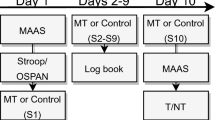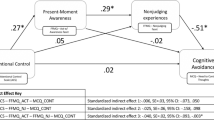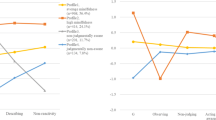Abstract
The successful outcomes of mindfulness derived interventions are well established and it has been suggested that cognitive factors may be responsible for the therapeutic benefits. With a sample of 296 individuals, we examined the mediating role of adaptive (i.e., effortful control) and maladaptive cognitive factors (i.e., repetitive negative thinking) in the relationship between the tendency to act mindfully and internalized and externalized problems, after controlling for confounding demographic and personal variables. We hypothesized that mindfulness would be positively related to effortful control, while inversely related to repetitive negative thinking. Furthermore, effortful control would be inversely related to internalized and externalized problems, while repetitive negative thinking would be positively related to these problems. Our results indicated that the original model could be improved by adding a path between mindfulness and internalized problems and by being more parsimonious. The final model provided an adequate fit for the data. Our findings are in line with theoretical models of mindfulness, which conceive its benefits in terms of cognitive process and self-regulation.


Similar content being viewed by others
References
Aldao, A., Nolen-Hoeksema, S., & Schweizer, S. (2010). Emotion-regulation strategies across psychopathology: a meta-analytic review. Clinical Psychology Review, 30, 217–237. doi:10.1016/j.cpr.2009.11.004.
American College Health Association & National College Health Assessment II. (2016). Canadian reference group executive summary. Retrieved from http://www.cacuss.ca/_Library/Provincial_Reports/NCHA-II_SPRING_2016_CANADIAN_REFERENCE_GROUP_EXECUTIVE_SUMMARY.pdf.
American Psychiatric Association. (2013). Diagnostic and statistical manual of mental disorders (5th ed.). Arlington: American Psychiatric Publishing.
Baer, R. A., Smith, G. T., Hopkins, J., Krietemeyer, J., & Toney, L. (2006). Using self-report assessment methods to explore facets of mindfulness. Assessment, 13, 27–45. doi:10.1177/1073191105283504.
Baer, R. A., Smith, G. T., Lykins, E., Button, D., Krietemeyer, J., Sauer, S., et al. (2008). Construct validity of the five facet mindfulness questionnaire in meditating and nonmeditating samples. Assessment, 15, 329–342. doi:10.1177/1073191107313003.
Bishop, S. R., Lau, M., Shapiro, S., Carlson, L., Anderson, N. D., Camody, J., et al. (2004). Mindfulness: a proposed operational definition. Clinical Psychology: Science and Practice, 11, 230–241. doi:10.1093/clipsy/bph077.
Borkovec, T. D., Ray, W. J., & Stober, J. (1998). Worry: a cognitive phenomenon intimately linked to affective, physiological, and interpersonal behavioral processes. Cognitive Therapy and Research, 22, 561–576.
Buss, A. H., & Perry, M. (1992). The aggression questionnaire. Personality Processes and Individual Differences, 63, 452–459.
Chiesa, A., Calati, R., & Serretti, A. (2011). Does mindfulness training improve cognitive abilities? A systematic review of neuropsychological findings. Clinical Psychology Review, 31, 449–464. doi:10.1016/j.cpr.2010.11.003.
Clark, L. A., & Watson, D. (1991). Tripartite model of anxiety and depression: psychometric evidence and taxonomic implications. Journal of Abnormal Psychology, 100, 316–336.
Evans, D. E., & Rothbart, M. K. (2007). Developing a model for adult temperament. Journal of Research in Personality, 41, 868–888. doi:10.1016/j.paid.2007.07.016.
Fresco, D. M., Frankel, A. N., Mennin, D. S., Turk, C. L., & Heimberg, R. G. (2002). Distinct and overlapping features of rumination and worry: the relationship of cognitive production to negative affective states. Cognitive Therapy and Research, 26, 179–188.
Gosselin, P., Dugas, M. J., Ladouceur, R., & Freeston, M. H. (2001). Evaluation of worry: validation of a French translation of the Penn State worry questionnaire. Encephale, 27, 475–484.
Grabovac, A. D., Lau, M. A., & Willett, B. R. (2011). Mechanisms of mindfulness: a buddhist psychological model. Mindfulness, 2, 154–166. doi:10.1007/s12671-011-0054-5.
Gu, J., Strauss, C., Bond, R., & Cavanagh, K. (2015). How do mindfulness-based cognitive therapy and mindfulness-based stress reduction improve mental health and wellbeing? A systematic review and meta-analysis of meditation studies. Clinical Psychology Review, 37, 1–12. doi:10.1016/j.cpr.2015.01.006.
Harvey, P. (2015). Mindfulness in Theravāda Samatha and Vipassanā meditations, and in secular mindfulness. In E. Shonin, W. Van Gordon, & N. N. Singh (Eds.), Buddhist foundations of mindfulness (pp. 115–137). Switzerland: Springer.
Heeren, A., Douilliez, C., Peschard, V., Debrauwere, L., & Philippot, P. (2011). Cross-cultural validity of the five facets mindfulness questionnaire: adaptation and validation in a French-speaking sample. Revue Européenne de Psychologie Appliquée, 61, 147–151. doi:10.1016/j.erap.2011.02.001.
Hölzel, B. K., Lazar, S. W., Gard, T., Schuman-Olivier, Z., Vago, D. R., & Ott, U. (2011). How does mindfulness meditation work? Proposing mechanisms of action from a conceptual and neural perspective. Perspective on Psychological Science, 6, 537–559. doi:10.1177/1745691611419671.
Hooper, D., Coughlan, J., & Mullen, M. R. (2008). Structural equation modelling: guidelines for determining model fit. In Electronic journal of business research methods Retrieved from http://www.ssnpstudents.com/wp/wp-content/uploads/2015/02/ejbrm-volume6-issue1-article183.pdf.
Kabat-Zinn, J. (1994). Wherever you go, there you are. New York: Hyperion.
Keng, S.-L., Smoski, M. J., & Robins, C. J. (2011). Effects of mindfulness on psychological health: a review of empirical studies. Clinical Psychology Review, 31, 1041–1056. doi:10.1016/j.cpr.2011.04.006.
Laverdière, O., Diguer, L., Gamache, D., & Evans, D. E. (2010). The french adaptation of the short form of the adult temperament questionnaire. European Journal of Psychological Assessment, 26, 212–219. doi:10.1027/1015-5759/a000028.
Marchand, W. R. (2014). Neural mechanisms of mindfulness and meditation: evidence from neuroimaging studies. World Journal of Radiology, 6, 471–479. doi:10.4329/WJR.v6.i7.471.
Meyer, T. J., Miller, M. L., Metzger, R. L., & Borkovec, T. D. (1990). Development and validation of the Penn State worry questionnaire. Behavioral Research and Therapy, 28, 487–495.
Nigg, J. T. (2006). Temperament and developmental psychopathology. Journal of Child Psychology and Psychiatry, 47, 395–422. doi:10.1111/j.1469-7610.2006.01612.x.
Nolen-Hoeksema, S., Wisco, B. E., & Lyubomirsky, S. (2008). Rethinking rumination. Perspectives on Psychological Science, 3, 400–424. doi:10.1111/j.1745-6924.2008.00088.x.
Norton, P. J., & Paulus, D. J. (2015). Toward a unified treatment for emotional disorders: update on the science and practice. Behavior Therapy, 47, 854–868. doi:10.1016/j.beth.2015.07.002.
Rothbart, M. K., & Rueda, M. R. (2005). The development of effortful control. In U. Mayr, E. Awh, & S. W. Keele (Eds.), Temperament: individual differences at the interface of biology and behavior (pp. 167–188). Washington, DC: American Psychological Association.
Scholten, W. D., Batelaan, N. M., Penninx, B. W. J. H., van Balkom, A. J. L. M., Smit, J. H., Schoevers, R. A., & van Oppen, P. (2016). Diagnostic instability of recurrence and impact on recurrence rates in depressive and anxiety disorders. Journal of Affective Disorders, 195, 185–190. doi:10.1016/j.jad.2016.02.025.
Shapiro, S. L., Carlson, L. E., Astin, J. A., & Freedman, B. (2006). Mechanisms of mindfulness. Journal of Clinical Psychology, 62, 373–386. doi:10.1002/jclp.20237.
Shelov, D. V., Suchday, S., & Friedberg, J. P. (2009). A pilot study measuring the impact of yoga on the trait of mindfulness. Behavioral and Cognitive Psychotherapy, 37, 595–598. doi:10.1017/S1352465809990361.
Treynor, W., Gonzalez, R., & Nolen-Hoeksema, S. (2003). Rumination reconsidered: a psychometric analysis. Cognitive Therapy and Research, 27, 247–259.
Vago, D. R., & Silbersweig, D. A. (2012). Self-awareness, self-regulation, and self-transcendence (S-ART): a framework for understanding the neurobiological mechanisms of mindfulness. Frontiers in Human Neuroscience, 6, 1–30. doi:10.3389/fnhum.2012.00296.
Wardenaar, K. J., van Veen, T., Giltay, E. J., de Beurs, E., Penninx, B. W. J. H., & Zitman, F. G. (2010). Development and validation of a 30-item short adaptation of the mood and anxiety symptoms questionnaire (MASQ). Psychiatry Research, 179, 101–106. doi:10.1016/j.psychres.2009.03.005.
Watkins, E. R. (2008). Constructive and uncontructive repetitive thought. Psychological Bulletin, 134, 163–206. doi:10.1037/0033-2909.134.2.163.
Funding
This study was partly funded by the Faculty of Graduate Studies and Research from our institution (grant number AY0309).
Author information
Authors and Affiliations
Corresponding author
Ethics declarations
Conflict of Interest
The authors declare that they have no conflict of interest.
Ethical Approval
All procedures performed in studies involving human participants were in accordance with the ethical standards of the institutional and/or national research committee and with the 1964 Helsinki declaration and its later amendments or comparable ethical standards.
Informed Consent
Informed consent was obtained from all individual participants included in the study
Disclosure
This manuscript is based on data also used in a doctoral dissertation. Some of the data from this paper were previously presented at the annual meeting of the Canadian Psychological Association in Victoria (June 2016).
Rights and permissions
About this article
Cite this article
Maltais, M., Bouchard, G. & Saint-Aubin, J. Mechanisms of Mindfulness: the Mediating Roles of Adaptive and Maladaptive Cognitive Factors. Curr Psychol 38, 846–854 (2019). https://doi.org/10.1007/s12144-017-9665-x
Published:
Issue Date:
DOI: https://doi.org/10.1007/s12144-017-9665-x




